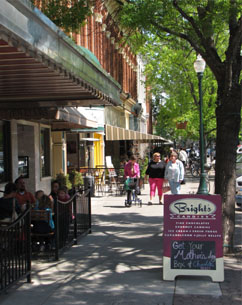Main Street Four-Point Approach®
The Main Street Four-Point
Approach® is a unique preservation-based economic development tool that
enables communities to revitalize downtown and neighborhood business
districts by leveraging local assets - from historic, cultural, and
architectural resources to local enterprises and community pride. It is a
comprehensive strategy that addresses the variety of issues and
problems that challenge traditional commercial districts.
Since
its founding in 1980, Main Street has been the leader of a
coast-to-coast network now encompassing more than 2,000 programs and
leaders who use the Main Street Approach® to rebuild the places and
enterprises that create sustainable, vibrant communities. This approach
has been implemented in over 1,200 cities and towns in 40 states across
the nation with the help of the National Main Street Center and
statewide downtown revitalization programs.The success of the
Main Street Approach® is based on its comprehensive nature. By carefully
integrating four points into a practical downtown management strategy, a
local Main Street program will produce fundamental changes in a
community’s economic basetional Main Street Center and statewide
downtown revitalization programs.
The four points and eight
guiding principles of the Main Street approach work together to build a
sustainable and complete community revitalization effort.
Organization
involves building a Main Street framework that is well represented by
business and property owners, bankers, citizens, historic
preservationists, entrepreneurs, public officials, chambers of commerce,
and other local economic development organizations. Everyone must work
together to renew downtown. A strong organization provides the structure
and stability to build and maintain a long-term effort.
Promotion
creates excitement and vibrancy downtown. Street festivals, parades,
retail events, and image development campaigns are some of the ways Main
Street provides education on what’s downtown and encourages customer
traffic. Promotion involves marketing an enticing image to shoppers,
investors, and visitors.
Design enhances the look
and feel of the commercial district. Historic building rehabilitation,
street and alley clean-up, landscaping, street furniture, signage,
visual merchandising and lighting all improve the physical image of the
downtown as a quality place to shop, work, walk, invest in, and live.
Design improvements result in a reinvestment of public and private
dollars to downtown.
Economic Restructuring
involves analyzing current market forces to develop long-term solutions.
Recruiting new businesses, creatively converting unused space for new
uses, and sharpening the competitiveness of Main Street’s traditional
merchants are examples of economic restructuring activities.
The Eight Guiding Principles
- Comprehensive.
A single project cannot revitalize a downtown or commercial
neighborhood. An ongoing series of initiatives is vital to build
community support and create lasting progress.
- Incremental.
Small projects make a big difference. They demonstrate that “things are
happening” on Main Street and hone the skills and confidence the
program will need to tackle more complex projects.
- Self-Help.
The state can provide valuable direction and technical assistance, but
only local leadership can breed long-term success by fostering and
demonstrating community involvement and commitment to the revitalization
effort.
- Public/Private Partnership. Every
local Main Street program needs the support and expertise of both the
public and private sectors. For an effective partnership, each must
recognize the strengths and weaknesses of the other.
- Identifying and Capitalizing on Existing Assets. Unique offerings and local assets provide the solid foundation for a successful Main Street initiative.
- Quality. From storefront design to promotional campaigns to special events, quality must be instilled in the organization.
- Change.
Changing community attitudes and habits is essential to bring about a
commercial district renaissance. A carefully planned Main Street program
will help shift public perceptions and practices to support and sustain
the revitalization process.
- Action Oriented.
Frequent visible changes in the look and activities of the commercial
district will reinforce the perception of positive change. Small, but
dramatic, improvements early in the process will remind the community
that the revitalization effort is underway
